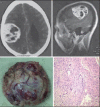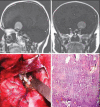Histological-subtypes and anatomical location correlated in meningeal brain tumors (meningiomas)
- PMID: 25002762
- PMCID: PMC4078607
- DOI: 10.4103/0976-3147.133568
Histological-subtypes and anatomical location correlated in meningeal brain tumors (meningiomas)
Abstract
Context: Not enough literature is available to suggest a link between the histological subtypes of intracranial meningeal brain tumors, called 'meningiomas' and their location of origin.
Aim: The evidence of correlation between the anatomical location of the intracranial meningiomas and the histopathological grades will facilitate specific diagnosis and accurate treatment.
Materials and methods: The retrospective study was conducted in a single high-patient-inflow Neurosurgical Center, under a standard and uniform medical protocol, over a period of 30 years from December 1982 to December 2012. The records of all the operated 729 meningiomas were analyzed from the patient files in the Medical Records Department. The biodata, x-rays, angiography, computed tomography (CT) scans, imaging, histopathological reports, and mortality were evaluated and results drawn.
Results: The uncommon histopathological types of meningiomas (16.88%) had common locations of origin in the sphenoid ridge, posterior parafalcine, jugular foramen, peritorcular and intraventricular regions, cerebellopontine angle, and tentorial and petroclival areas. The histopathological World Health Organization (WHO) Grade I (Benign Type) meningiomas were noted in 89.30%, WHO Grade II (Atypical Type) in 5.90%, and WHO Grade III (Malignant Type) in 4.80% of all meningiomas. Meningiomas of 64.60% were found in females, 47.32% were in the age group of 41-50 years, and 3.43% meningiomas were found in children. An overall mortality of 6.04% was noted. WHO Grade III (malignant meningiomas) carried a high mortality (25.71%) and the most common sites of meningiomas with high mortality were: The cerebellopontine angles, intraventricular region, sphenoid ridge, tuberculum sellae, and the posterior parafalcine areas.
Conclusion: The correlation between the histological subtypes and the anatomical location of intracranial meningeal brain tumors, called meningiomas, is evident, but further research is required to establish the link.
Keywords: Anatomical origin; correlation; histological types; intracranial meningiomas.
Conflict of interest statement
Figures





Similar articles
-
Management of intracranial meningiomas in Enugu, Nigeria.Surg Neurol Int. 2012;3:110. doi: 10.4103/2152-7806.101788. Epub 2012 Sep 28. Surg Neurol Int. 2012. PMID: 23087826 Free PMC article.
-
Pathodiagnostic parameters for meningioma grading.J Clin Neurosci. 2008 Dec;15(12):1370-5. doi: 10.1016/j.jocn.2007.12.005. Epub 2008 Sep 26. J Clin Neurosci. 2008. PMID: 18819804
-
Magnetic resonance imaging and histological classification of intracranial meningiomas in 112 dogs.J Vet Intern Med. 2008 May-Jun;22(3):586-95. doi: 10.1111/j.1939-1676.2008.00042.x. Epub 2008 May 2. J Vet Intern Med. 2008. PMID: 18466258
-
Primary extradural meningiomas: a report on nine cases and review of the literature from the era of computerized tomography scanning.J Neurosurg. 2000 Dec;93(6):940-50. doi: 10.3171/jns.2000.93.6.0940. J Neurosurg. 2000. PMID: 11117866 Review.
-
Pediatric meningiomas: a single-center experience with 15 consecutive cases and review of the literature.Childs Nerv Syst. 2012 Nov;28(11):1887-96. doi: 10.1007/s00381-012-1823-8. Epub 2012 Jun 6. Childs Nerv Syst. 2012. PMID: 22669518 Review.
Cited by
-
Clear cell meningiomas-case presentation, review of radiographic identifiers, and treatment approaches.Childs Nerv Syst. 2024 Jul;40(7):1989-1996. doi: 10.1007/s00381-024-06390-z. Epub 2024 Apr 18. Childs Nerv Syst. 2024. PMID: 38637336 Free PMC article. Review.
-
Variants of meningiomas: a review of imaging findings and clinical features.Jpn J Radiol. 2016 Jul;34(7):459-69. doi: 10.1007/s11604-016-0550-6. Epub 2016 May 2. Jpn J Radiol. 2016. PMID: 27138052 Review.
-
Recurrence of Resected Skull Base Meningiomas during Long-term Follow-up: Incidence and Predisposing Factors.J Neurol Surg B Skull Base. 2024 Apr 30;86(3):245-253. doi: 10.1055/s-0044-1786370. eCollection 2025 Jun. J Neurol Surg B Skull Base. 2024. PMID: 40351886 Free PMC article.
-
Somatic AKT1 mutations cause meningiomas colocalizing with a characteristic pattern of cranial hyperostosis.Am J Med Genet A. 2016 Oct;170(10):2605-10. doi: 10.1002/ajmg.a.37737. Epub 2016 Aug 23. Am J Med Genet A. 2016. PMID: 27550858 Free PMC article.
-
Intracranial intricacies: Comprehensive analysis of rare skull base meningiomas-A single-center case series.Clin Case Rep. 2023 Dec 28;12(1):e8376. doi: 10.1002/ccr3.8376. eCollection 2024 Jan. Clin Case Rep. 2023. PMID: 38161648 Free PMC article.
References
-
- Okonkwo DO, Laws ER. Meningiomas: Historical perspective. In: Lee JH, editor. Meningiomas: Diagnosis, Treatment, and Outcome. London: Springer-Verlag; 2009. pp. 3–11.
-
- Perry A, Stafford SL, Scheithauer BW, Suman VJ, Lohse CM. Meningioma grading: An analysis of histologic parameters. Am J Surg Pathol. 1997;21:1455–65. - PubMed
-
- Kaye H. Posterior fossa meningiomas. In: Sindou M, editor. Practical Handbook of Neurosurgery: From Leading Neurosurgeons. Vol. 2. Germany: Springer-Verlag; 2009. p. 181.
-
- Bondy M, Ligon BL. Epidemiology and etiology of intracranial meningiomas: A review. J Neurooncol. 1996;29:197–205. - PubMed
-
- Marin Sanabria EA, Ehara K, Tamaki N. Surgical experience with skull base approaches for foramen magnum meningioma. Neurol Med Chir (Tokyo) 2002;42:472–80. - PubMed
LinkOut - more resources
Full Text Sources
Other Literature Sources
